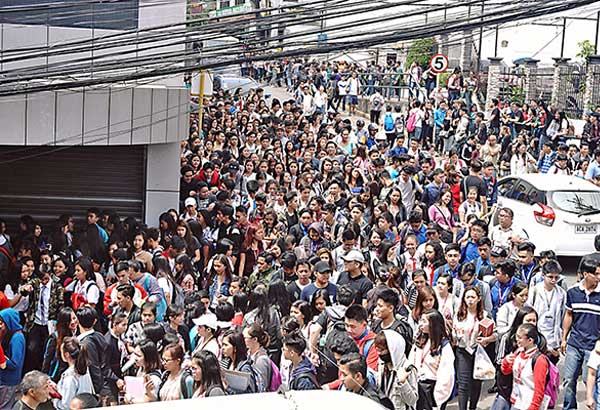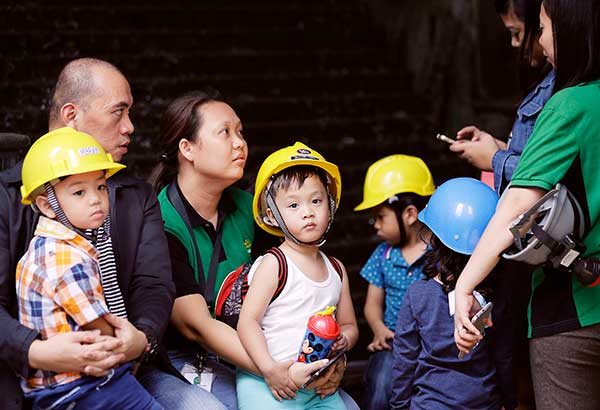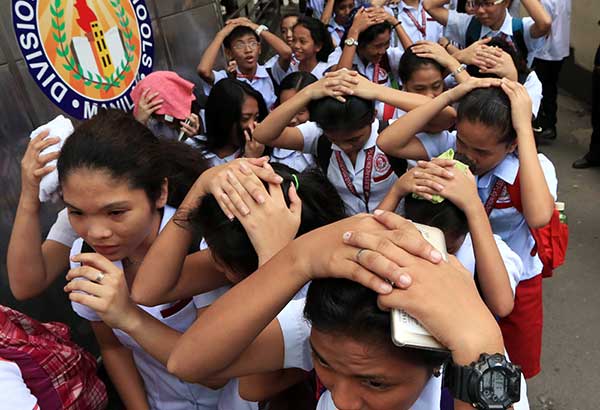‘This is not a drill’

Students and teaching staff of the University of Baguio gather outside the main school building after a strong earthquake was felt in the city and other parts of Luzon yesterday. ANDY ZAPATA JR.
6.3 quake jolts Luzon
MANILA, Philippines - People ran into the streets in panic and classes were suspended in several schools as a powerful earthquake caused buildings to shake, triggering fears that the “big one” had struck.
No injuries were reported.
Seismologists said the quake along the “Manila Trench” was centered in Batangas where it was registered at magnitude 6.3.
The quake was strongest in Nasugbu, Batangas and in Metro Manila, where it was felt at Intensity 4.
In Manila, where people have been bracing for the “big one” from the West Valley Fault, light railway services were halted as the trains were jolted for nearly half a minute.
Students filed out of schools with their hands over their heads, as they had done in previous earthquake exercises, except this time, school authorities barked with urgency that “this is not a drill.”
In the streets, people including children were seen wearing helmets.
Fearing aftershocks, it took time before people began returning to offices, schools and homes.
When the quake struck, Martin Novicio, an employee of the Metropolitan Manila Development Authority (MMDA), immediately called on his colleagues to vacate their eight-story building and proceed to an open area.
“Let us apply what we have learned during our training. Please evacuate from the building. This is real, this is no longer an earthquake drill and this is not a joke,” Novicio said as he kept egging the employees to rush out from the decades-old MMDA building in Makati City.
This was the same scenario in Quezon City, where officials also reminded employees of Quezon City Hall that this was no drill.
Myke Marasigan, head of the Quezon City Disaster Risk Reduction Management Office, said an evacuation of the whole Quezon City Hall building and compound was ordered following the earthquake.
Office workers and students in Metro Manila briefly evacuated their buildings after feeling the moderately strong swaying and shaking.
Buildings in Manila and other nearby areas swayed, while employees of Malacañang and other government buildings were evacuated.
Manila’s disaster response chief Johnny Yu said tenants and employees at the Pacific Center Building along Quintin Paredes

Children wear helmets as families are evacuated from a high-rise building in Manila following an earthquake yesterday. The earthquake’s epicenter was five kilometers southwest of Lian, Batangas. AP
Street in Binondo district were evacuated as its engineers reported cracks in portions of the structure.
Shortly after, the building “was declared safe by their engineers,” he added.
The buildings in the nearby town of Bacoor in Cavite were also evacuated, witnesses said.
“City hall employees as well as those transacting business there were ordered to leave the building as a precaution,” government lawyer Bugsy del Rosario said from Bacoor.
Television footage also showed photos of students standing outside schools.
“It wasn’t really that strong. We did not see anyone running out of buildings here,” fire officer John Christopher Carandang said from Lian, Batangas, near the epicenter of the quake.
Commuters of the Light Rail Transit (LRT) system also felt the quake as the train stopped on the tracks as coaches began to sway during the tremor.
The Philippine National Railways (PNR) also suspended operations after the quake.
“Ongoing inspection on bridges and rail tracks are being done to ensure safety,” the PNR said.
Several schools, including De La Salle University in Manila, Pamantasan ng Lungsod ng Maynila, Far Eastern University, University of the East and Lyceum of Batangas, suspended afternoon classes due to fear of aftershocks.
The Philippine Institute of Volcanology and Seismology (Phivolcs) said no damage was expected because the magnitude 6.3 earthquake struck at a depth of 160 kilometers.
Deeper epicenters often cause less damage on the Earth’s surface, though they can be widely felt.
The tremor struck at 1:28 p.m., with its epicenter traced some kilometers southwest of Nasugbu, Batangas.
The tremor was felt as far north as Olongapo City and Pampanga, prompting suspension of work and classes.
Imus, in Cavite, and Taguig in Metro Manila also suspended work and school immediately after the earthquake.
“I felt the shaking, but it did not last that long,” said Marjorie Caubalejo, a beach resort worker in Nasugbu, the town nearest to the epicenter.
Caubalejo said she and her co-workers went out of their office when they felt the tremor, but most of their guests were swimming and did not notice the earthquake. Power was not interrupted, she added.
Batangas officials reported no casualties and damage in the quake.

Students evacuate the Araullo High School in Manila after a 6.3 magnitude earthquake yesterday. EDD GUMBAN
The regional Office of Civil Defense said there were no immediate reports of casualty and damage or casualty following yesterday’s tremor.
“There’s no damage reported yet. Our local officials are still conducting damage assessment in their respective localities,” regional OCD spokesperson Georgina Garcia said.
“As per our monitoring, there was suspension of classes in several areas of Cavite and Laguna,” Garcia said.
The National Disaster Risk Reduction and Management Council (NDRRMC) issued an immediate advisory for the people to remain calm and closely monitor the situation.
Too deep
The quake, which had an initial magnitude of 6.1, was felt at Intensity 4 – classified as moderately strong – in Nasugbu, Calatagan and Balayan, Batangas; Manila; Parañaque City; Pasig City; Taguig City; Pasay City; Rosario, Maragondon, Noveleta and Dasmariñas, Cavite; Floridablanca, Pampanga; and Olongapo City, Subic and Iba, Zambales.
Intensity 3 was felt in Puerto Galera, Oriental Mindoro; San Jose, Occidental Mindoro; Tagaytay City; Canlubang and Calamba, Laguna; Indang and Alfonso, Cavite; Bocaue, Malolos, Obando and Balagtas, Bulacan; Dagupan City and Lingayen, Pangasinan; Dau, Pampanga; Bagac, Bataan; Baguio City; Pateros; Quezon City; Makati City; San Juan City; Marikina City; and Cainta and San Mateo, Rizal.
Intensity 2 in Santa Rosa, Laguna; Gasan, Marinduque; Magalang and Santo Tomas, Pampanga; and Tanauan City, Batangas; and Intensity 1 in Talisay, Batangas; Pantabangan, Nueva Ecija; Meycauayan, Bulacan; and Atok, Benguet.
Phivolcs warned residents near the epicenter of the quake against possible aftershocks.
Science Undersecretary Renato Solidum, also the officer-in-charge of Phivolcs, said the quake was too deep to generate stronger aftershocks.
“There can be aftershocks but because the depth was more than 100 km, most likely the aftershocks would not be felt, or some may be felt but these would not be destructive shaking,” Solidum said.
Netizens posted several photos of people fleeing office and school buildings after the strong tremor.
Twitter handler @ConceptGrp said the shaking was felt for about 15 seconds in Makati City.
Solidum explained people who were in upper floors of buildings felt the quake at higher intensities than those at ground level.
The quake, which had a depth of 160 km, was generated by a movement along the Manila Trench, located west of Luzon, Phivolcs said.
The tremor revived fears among Metro Manila residents of the “Big One,” a magnitude 7.2 earthquake to be generated by the West Valley Fault, which is ripe for movement.
The West Valley Fault is a 100-km fault that traverses parts of Bulacan, Quezon City, Marikina, Makati, Pasig, Taguig and Muntinlupa in Metro Manila; San Pedro, Biñan, Sta. Rosa, Cabuyao and Calamba in Laguna; and Carmona, General Mariano Alvarez and Silang in Cavite.
Based on a 2004 study of the Japan International Cooperation Agency, the magnitude 7.2 quake could kill up to 34,000 people and injure 100,000 others due to collapsed buildings.
Solidum said yesterday’s quake could not trigger the movement of other active faults such as the West Valley Fault.
Solidum, however, emphasized the importance of earthquake preparedness as there are several faults that could trigger strong tremors in the country.
“The (Batangas) earthquake is not that strong, the movement of the (Manila) trench is not significant,” he said.
“Earthquake preparedness is important in case of strong earthquakes to be triggered by other earthquake generators,” he added.
The Philippines sits on the so-called Pacific Ring of Fire, an area where earthquakes and volcanic activities are common.
About 20 quakes hit the country every day but only a few are felt.
Last month a magnitude 6.5 quake killed two people and heavily damaged power generation plants in Ormoc, Leyte, leaving large areas of the central Philippines without power for weeks.
Eight people also died and more than 250 were injured following a magnitude 6.5 quake outside Surigao City in February.
The latest major quake to hit the Philippines was in 2013, when a magnitude 7.1 quake left more than 220 people dead and destroyed historic churches in Bohol. – Janvic Mateo, Emmanuel Tupas, Ric Sapnu, Jaime Laude, Romina Cabrera, Ghio Ong, Michelle Zoleta, AFP, AP
- Latest
- Trending




























